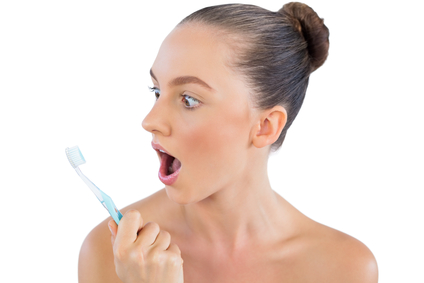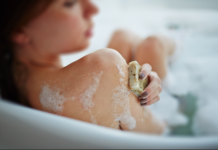If you’re like most people, you brush your teeth two or three times a day. It’s a normal routine you hardly have to think about. One thing you may never have considered is just how gross toothbrushes can get after a while.
Let’s take a closer look at what could be lurking on your toothbrush right now:
1. Fecal Matter
Do you keep your toilet lid up or down when you flush? Your answer could mean the difference between a toothbrush infected with coliform bacteria (fecal bacteria) and one that isn’t. E. coli is one of the more well-known coliform bacteria. This bacteria commonly causes gastroenteritis. Be sure to keep that lid down when you flush!
2. Blood
If you notice blood in the sink when you brush or floss, you could have gingivitis. According to the Centers for Disease Control, 47.2 percent of adults have some sort of periodontal disease. A visit to the dentist can help clear away built-up tarter and give your gums a chance to heal. As a rule, the more inflammation in your mouth, the more inflammation in your bloodstream!
3. Candida
Candida is a fungus that can cause oral yeast infections (thrush), vaginal yeast infections, skin yeast infections, and systemic candidiasis. The most common strain in humans is Candida albicans. This fungus has also been linked to a high rate of tooth decay in children. Virtually everyone has some Candida in their system. It only becomes a problem when it is able to colonize. A healthy diet, good vitamin and mineral supplementation, and the right probiotics are the best way to keep Candida from colonizing.
Often, despite our best efforts, Candida will colonize due to the use of antibiotics, steroid medication, or a comprised immune system.
4. Food Particles
The late-night snack you indulged in before retiring could make a repeat appearance in your mouth when you brush the next morning. Decrease your chances of food particles hanging out on your toothbrush by flossing before you brush and rinsing your toothbrush thoroughly after each use. Don’t give bacteria anything to “feast” on!
5. Staphylococcus Aureus
Staphylococcus aureus is often found in the respiratory tract and on skin. It has the ability to cause infection, most often cellulitis, abscesses, and boils. MRSA is a strain of Staphylococcus aureus which has become resistant to multiple antibiotics.
6. Streptococcus Mutans
Streptococcus mutans is found in the deep crevices of biting teeth and is the main culprit behind bad breath and tooth decay.
7. Herpes Simplex Type I
This virus is the one most commonly associated with the development of cold sores. If you have an active outbreak, the virus can remain on your toothbrush for up to a week. The concern here is infecting others. Don’t share toothbrushes or store them together.
8. Human Papillomavirus
Human papillomavirus (HPV) has been linked to the development of esophageal, oral, and cervical cancers. Over 100 strains of this virus have been identified. If you are infected with HPV, it could be possible to pass it along to someone else if you share a toothbrush, or store toothbrushes together. The good news is, you can boost your immune system to fight HPV naturally. Ongoing research in this field reveals that about 90% of people are able to clear this virus from their system within two years of becoming infected.
9. Pseudomonas Aeruginosa
Pseudomonas is able to cause many types of infection including skin, bone, respiratory, and urinary. In a bathroom setting, Pseudomonas is usually associated with eye infections from improper cleaning of contact lenses after handling a toothbrush contaminated with Pseudomonas.
10. Toxic Chemicals
There are a lot of toxic chemicals in many conventional cleaners, cosmetics, and hair care products. If you use them around an exposed toothbrush, you could be swallowing parabens, phthalates, and dioxins each time you brush. These chemicals have been linked to the development of neurological disorders, infertility, and cancer.
Eliminate as many of them from your environment as possible.
You can disinfect your toothbrush naturally with a combination of vinegar, baking soda, and water. Pour half a cup of water into a glass. Add two tablespoons of white vinegar and two teaspoons of baking soda and mix well. Place your toothbrush upside down into the mixture and let it soak for 30 minutes. Rinse thoroughly.
Remember to replace your toothbrush at least every three months, keep toothbrushes separate, never share them, and get regular dental cleanings.
Germs Are Everywhere!
Read Next:








